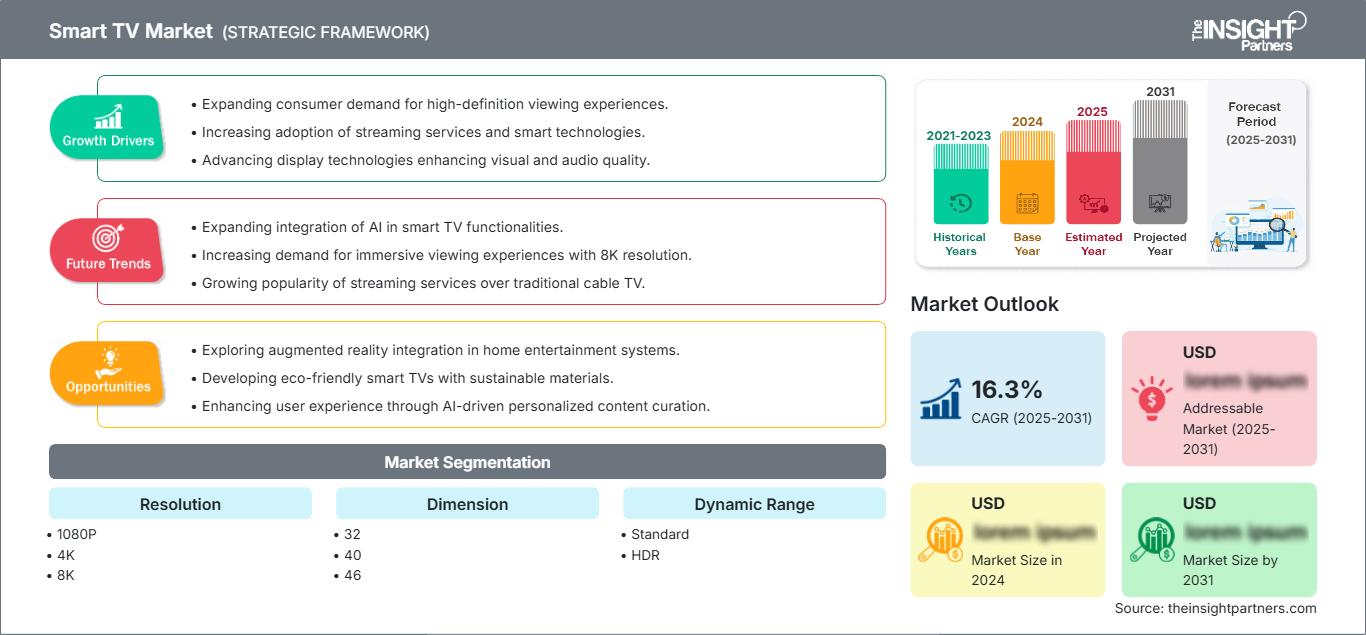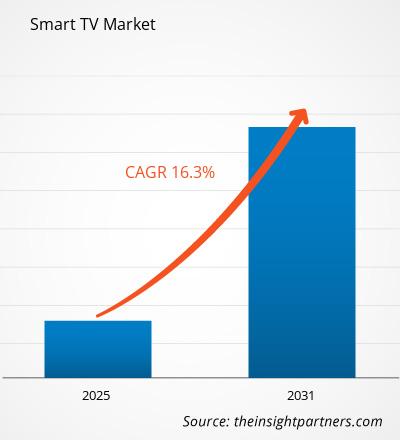Der Smart-TV-Markt wird voraussichtlich zwischen 2025 und 2031 eine durchschnittliche jährliche Wachstumsrate (CAGR) von 16,3 % verzeichnen, wobei die Marktgröße von XX Millionen US-Dollar im Jahr 2024 auf XX Millionen US-Dollar im Jahr 2031 anwachsen wird.
Der Bericht ist nach Auflösung (1080P, 4K, 8K, Sonstige), Größe (32, 40, 46, 55, 75 und höher), Dynamikumfang (Standard, HDR) und Anwendung (Privat, Gewerbe) segmentiert. Die globale Analyse ist weiter nach Regionen und wichtigen Ländern aufgeschlüsselt. Der Bericht bietet den Wert in USD für die obige Analyse und Segmente.
Zweck des Berichts
Der Bericht „Smart-TV-Markt“ von The Insight Partners zielt darauf ab, die aktuelle Situation und das zukünftige Wachstum sowie die wichtigsten treibenden Faktoren, Herausforderungen und Chancen zu beschreiben. Dadurch erhalten verschiedene Geschäftsinteressenten Einblicke, beispielsweise:
- Technologieanbieter/-hersteller: Um die sich entwickelnde Marktdynamik zu verstehen und die potenziellen Wachstumschancen zu kennen, sodass sie fundierte strategische Entscheidungen treffen können.
- Investoren: Um eine umfassende Trendanalyse hinsichtlich der Marktwachstumsrate, der finanziellen Marktprognosen und der Chancen entlang der Wertschöpfungskette durchzuführen.
- Regulierungsbehörden: Um Richtlinien und Überwachungsaktivitäten auf dem Markt zu regulieren, mit dem Ziel, Missbrauch zu minimieren, das Vertrauen der Investoren zu wahren und die Integrität und Stabilität des Marktes aufrechtzuerhalten.
Smart-TV-Marktsegmentierung Auflösung
- 1080P
- 4K
- 8K
- Andere
Abmessungen
- 32
- 40
- 46
- 55
- 75 und mehr
Dynamikbereich
- Standard
- HDR
Anwendung
- Wohnbereich
- Gewerbe
Sie erhalten kostenlos Anpassungen an jedem Bericht, einschließlich Teilen dieses Berichts oder einer Analyse auf Länderebene, eines Excel-Datenpakets sowie tolle Angebote und Rabatte für Start-ups und Universitäten.
Smart-TV-Markt: Strategische Einblicke

- Holen Sie sich die wichtigsten Markttrends aus diesem Bericht.Dieses KOSTENLOSE Beispiel umfasst Datenanalysen, die von Markttrends bis hin zu Schätzungen und Prognosen reichen.
Wachstumstreiber für Smart-TV-Markt
- Steigende Verbrauchernachfrage nach Streaming-Inhalten: Die zunehmende Beliebtheit von Streaming-Diensten wie Netflix, Hulu und Amazon Prime Video ist ein wichtiger Treiber des Smart-TV-Marktes. Verbraucher suchen zunehmend nach Geräten, die nahtlosen Zugriff auf eine Vielzahl von Online-Inhalten wie Filme, Fernsehsendungen und Live-Sport bieten. Smart-TVs mit integrierten Apps und benutzerfreundlichen Oberflächen erfüllen diese Nachfrage durch direktes Streaming. Da immer mehr Haushalte auf herkömmliche Kabelabonnements verzichten, wächst der Wunsch nach Smart-TVs mit verbessertem Fernseherlebnis weiter und steigert die Marktumsätze.
- Fortschritte in der Displaytechnologie: Kontinuierliche Fortschritte in der Displaytechnologie, wie 4K, OLED und QLED, treiben den Smart-TV-Markt voran. Diese Technologien verbessern die Bildqualität und bieten Verbrauchern schärfere Bilder, lebendige Farben und verbesserten Kontrast. Da Hersteller Innovationen entwickeln und neue Funktionen einführen, interessieren sich Verbraucher zunehmend für leistungsstarke Smart-TVs, die ein überragendes Fernseherlebnis bieten. Darüber hinaus fördert die zunehmende Verfügbarkeit hochauflösender Inhalte die Einführung fortschrittlicher Displaytechnologien und treibt die Nachfrage nach Smart-TVs weiter an.
- Integration von Smart-Home-Ökosystemen: Der wachsende Trend zur Smart-Home-Automatisierung beeinflusst den Smart-TV-Markt erheblich. Verbraucher suchen nach Geräten, die sich nahtlos in ihre bestehenden Smart-Home-Systeme integrieren lassen, wie z. B. Sprachassistenten (z. B. Amazon Alexa, Google Assistant) und Hausautomationsprodukte. Smart-TVs, die mit verschiedenen Smart-Home-Geräten kompatibel sind, bieten zusätzlichen Komfort und ein verbessertes Benutzererlebnis. Mit der Weiterentwicklung des Marktes wird die Möglichkeit, Smart-Home-Funktionen über Smart-TVs zu steuern, zu einem wesentlichen Merkmal, das das Interesse der Verbraucher steigert und das Marktwachstum fördert.
Zukünftige Trends im Smart-TV-Markt
- Aufstieg von künstlicher Intelligenz und Personalisierung: Die Integration künstlicher Intelligenz (KI) in Smart-TVs wird zu einem wichtigen Trend und verbessert das Benutzererlebnis durch personalisierte Inhaltsempfehlungen und intelligentere Schnittstellen. KI-Algorithmen analysieren Sehgewohnheiten und Vorlieben, um relevante Sendungen, Filme und Anwendungen vorzuschlagen und es Nutzern so zu erleichtern, neue Inhalte zu entdecken. Da Smart-TVs intuitiver werden und auf individuelle Vorlieben eingehen, wird dieser Trend voraussichtlich die Erwartungen der Verbraucher prägen und weitere Innovationen auf dem Smart-TV-Markt vorantreiben.
- Verlagerung hin zu abonnementbasierten Modellen: Es gibt einen wachsenden Trend zu abonnementbasierten Modellen für die Bereitstellung von Inhalten auf Smart-TVs. Viele Verbraucher bevorzugen die Flexibilität, verschiedene Streaming-Dienste zu abonnieren, anstatt sich an traditionelle Kabelpakete zu binden. Dieser Wandel führt zur Entstehung gebündelter Abonnementdienste, bei denen Verbraucher über ein einziges Paket auf mehrere Plattformen zugreifen können. Da dieser Trend an Fahrt gewinnt, werden Smart-TV-Hersteller wahrscheinlich Partnerschaften mit Streaming-Diensten eingehen, um exklusive Pakete anzubieten, die das Gesamtwertversprechen für Verbraucher verbessern und den Smart-TV-Umsatz steigern.
Marktchancen für Smart-TVs
- Expansion von Gaming und E-Sports: Die boomende Gaming-Branche bietet lukrative Möglichkeiten für den Smart-TV-Markt. Mit dem Aufstieg von Online-Gaming und E-Sports suchen Verbraucher zunehmend nach Smart-TVs, die hohe Bildwiederholraten, geringe Latenzzeiten und immersive Grafiken bieten. Hersteller können diesen Trend nutzen, indem sie Smart-TVs entwickeln, die speziell für Gaming-Erlebnisse optimiert sind und über dedizierte Gaming-Modi und Kompatibilität mit gängigen Spielekonsolen verfügen. Durch die gezielte Ausrichtung auf die Gaming-Zielgruppe können Unternehmen ihre Marktreichweite erweitern und den Umsatz in diesem wachsenden Segment steigern.
- Akzeptanz in Schwellenländern: Die Verbreitung von Smart-TVs in Schwellenländern bietet erhebliche Wachstumschancen. Mit steigenden verfügbaren Einkommen und zunehmender Internetdurchdringung in Regionen wie dem asiatisch-pazifischen Raum, Afrika und Lateinamerika möchten immer mehr Verbraucher ihre Unterhaltungssysteme aufrüsten. Unternehmen können ihre Marketingstrategien und Produktangebote an die individuellen Bedürfnisse und Vorlieben dieser Märkte anpassen, beispielsweise durch die Bereitstellung erschwinglicher Smart-TV-Optionen mit lokalisierten Inhalten. Dieser strategische Fokus auf Schwellenmärkte kann zu erheblichem Umsatzwachstum führen und die Markenpräsenz weltweit stärken.
Regionale Einblicke in den Smart-TV-Markt
Die Analysten von The Insight Partners haben die regionalen Trends und Faktoren, die den Smart-TV-Markt im Prognosezeitraum beeinflussen, ausführlich erläutert. In diesem Abschnitt werden auch die Marktsegmente und die geografische Lage in Nordamerika, Europa, dem asiatisch-pazifischen Raum, dem Nahen Osten und Afrika sowie Süd- und Mittelamerika erörtert.
Umfang des Smart-TV-Marktberichts
| Berichtsattribut | Einzelheiten |
|---|---|
| Marktgröße in 2024 | US$ XX million |
| Marktgröße nach 2031 | US$ XX Million |
| Globale CAGR (2025 - 2031) | 16.3% |
| Historische Daten | 2021-2023 |
| Prognosezeitraum | 2025-2031 |
| Abgedeckte Segmente |
By Auflösung
|
| Abgedeckte Regionen und Länder | Nordamerika
|
| Marktführer und wichtige Unternehmensprofile |
|
Dichte der Smart-TV-Marktakteure: Auswirkungen auf die Geschäftsdynamik verstehen
Der Smart-TV-Markt wächst rasant. Die steigende Nachfrage der Endnutzer ist auf Faktoren wie veränderte Verbraucherpräferenzen, technologische Fortschritte und ein stärkeres Bewusstsein für die Produktvorteile zurückzuführen. Mit der steigenden Nachfrage erweitern Unternehmen ihr Angebot, entwickeln Innovationen, um den Bedürfnissen der Verbraucher gerecht zu werden, und nutzen neue Trends, was das Marktwachstum weiter ankurbelt.

- Holen Sie sich die Smart-TV-Markt Übersicht der wichtigsten Akteure
Wichtige Verkaufsargumente
- Umfassende Abdeckung: Der Bericht analysiert umfassend Produkte, Dienstleistungen, Typen und Endnutzer des Smart-TV-Marktes und bietet einen ganzheitlichen Überblick.
- Expertenanalyse: Der Bericht basiert auf dem umfassenden Verständnis von Branchenexperten und Analysten.
- Aktuelle Informationen: Der Bericht gewährleistet Geschäftsrelevanz durch die Berichterstattung über aktuelle Informationen und Datentrends.
- Anpassungsoptionen: Dieser Bericht kann an spezifische Kundenanforderungen angepasst werden und passt sich so optimal an die Geschäftsstrategien an.
Der Forschungsbericht zum Smart-TV-Markt kann daher dabei helfen, die Branchensituation und die Wachstumsaussichten zu entschlüsseln und zu verstehen. Obwohl es einige berechtigte Bedenken geben mag, überwiegen die Vorteile dieses Berichts tendenziell die Nachteile.
- Historische Analyse (2 Jahre), Basisjahr, Prognose (7 Jahre) mit CAGR
- PEST- und SWOT-Analyse
- Marktgröße Wert/Volumen – Global, Regional, Land
- Branchen- und Wettbewerbslandschaft
- Excel-Datensatz
Aktuelle Berichte
Verwandte Berichte
Erfahrungsberichte
Grund zum Kauf
- Fundierte Entscheidungsfindung
- Marktdynamik verstehen
- Wettbewerbsanalyse
- Kundeneinblicke
- Marktprognosen
- Risikominimierung
- Strategische Planung
- Investitionsbegründung
- Identifizierung neuer Märkte
- Verbesserung von Marketingstrategien
- Steigerung der Betriebseffizienz
- Anpassung an regulatorische Trends




















 Kostenlose Probe anfordern für - Smart-TV-Markt
Kostenlose Probe anfordern für - Smart-TV-Markt